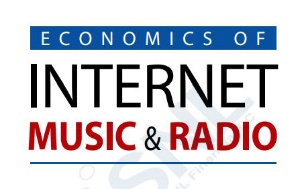 SNL Kagan, a division of SNL Financial, released the 2014 edition of Economics of Internet Music and Radio, a map of the online audio landscape and financial projections. “It’s a top-line analysis of the sector,” Senior Research Analyst Justin Nielson told RAIN in a phone call.
SNL Kagan, a division of SNL Financial, released the 2014 edition of Economics of Internet Music and Radio, a map of the online audio landscape and financial projections. “It’s a top-line analysis of the sector,” Senior Research Analyst Justin Nielson told RAIN in a phone call.
The study considers pureplay Internet music services in detail, and also makes separate financial revenue projections for digital streams of broadcast radio. In both cases, SNL Kagan projects 10 years out, forecasting economic growth through 2023. The year-over-year growth percentages for both sides of the industry diminish over the 10-year span, showing a leveling-off of the growth curve during that period.
On the pureplay side, SNL Kagan’s research predicts advertising revenue to grow from $880-million in 2013 to $3.2-billion in 2023 — at which point pureplay music advertising revenue will comprise 3.6% of total online ad revenue across all sectors in the U.S.
Less dramatic economic growth is forecast for the online advertising revenue of broadcast radio, rising from $889-million in 2013 to $1.6-billion in 2023. Within that projection there is a gradual rise of the percentage of total income earned by online advertising, peaking at 7.8% in 2023.
When we spoke to Justin Nielson, he emphasized the importance of mobile distribution in the business growth of online audio, via portable devices and connected cars.
“That was our focus in the report,” said Nielson. “On the broadcaster side, their digital initiatives in mobile apps and connected cars. From pureplay Internet radio we also see the emergence of applications for the connected car. We looked at the advertising potential for those utilities in the car.”
The report does not shy away from delineating the challenges faced by online music services, which it summarizes frankly: “The most significant common factor for all these services — new or old, free or subscription — is that a profitable business model has yet to be established, and music licensing fees continue to be a burden.”
We asked Justin Nielson about those economic hurdles, as well as corresponding issues of a glutted market and lack of differentiation among services which offer similar features. How can any pureplay service break through?
“I think distribution in mobile is the primary focus,” Nielson told us. “An example is Pandora, which tries to be everywhere its listeners are. The biggest opportunity is in the car. Broadcast radio has had a primary distribution point in the car. Others are trying to get into radio’s area of expertise, and make their service as easy to use in the car as radio. That’s a big initiative. Also: local advertising, trying to replicate the local advertising flavor that broadcast radio has done such a good job with.”
Nielson also noted the disadvantage faced by Internet businesses over the cost of content: “They are definitely at a disadvantage because broadcast radio doesn’t pay a performance right fee for transmission over the air.”
Business modeling plays a part in the industry’s devlopment, according to Nielson. “Looking at the evolution of the Internet radio space, you see more subscription models added to platforms. You also see more partnerships with wireless providers like Beats Music with AT&T, and Spotify with Sprint. They’re trying to have other revenue models outside of just advertising.”
In addition to the economic analysis, Economics of Internet Music and Radio presents a descriptive overview of music services with data points for each. It pulls together research from a wide range of sources to describe how the industry is shaped in 2014.
